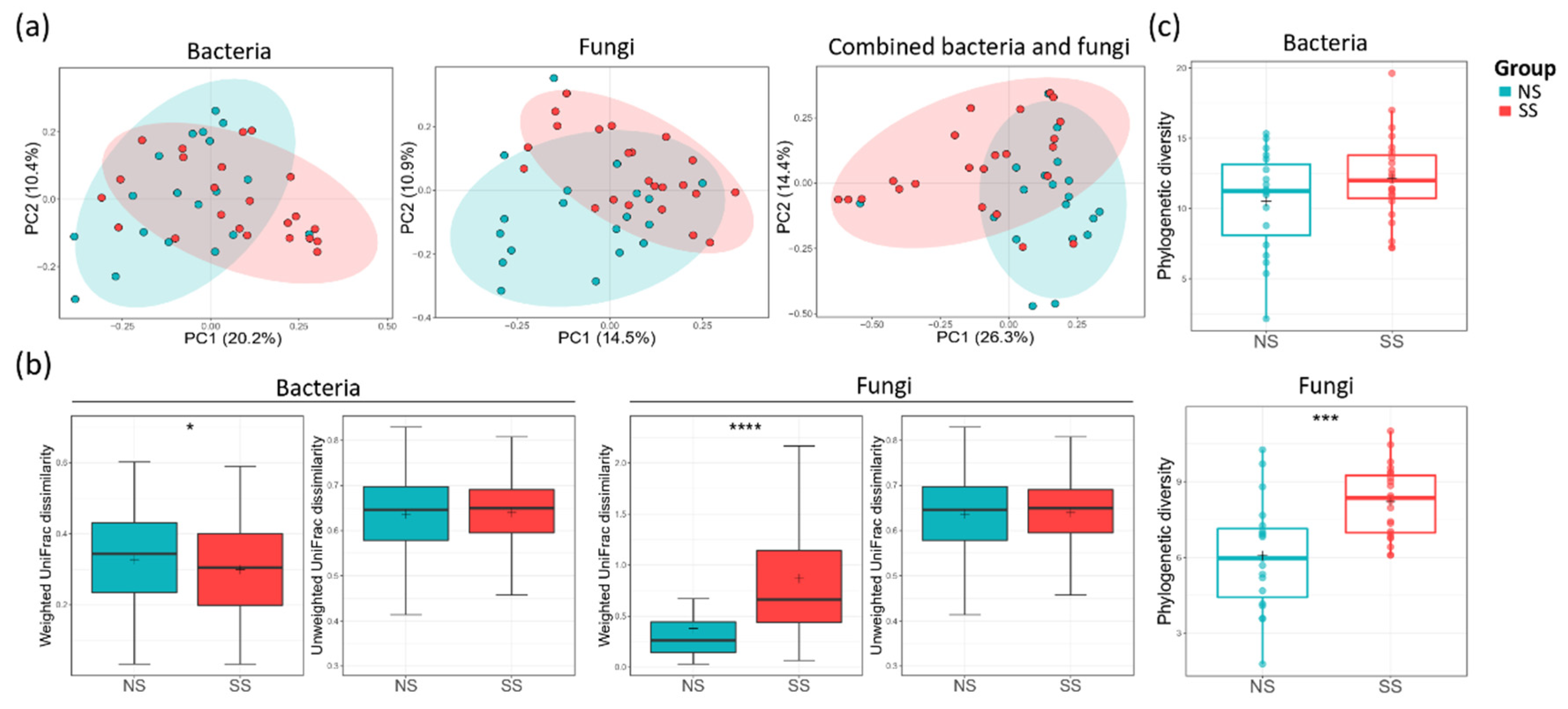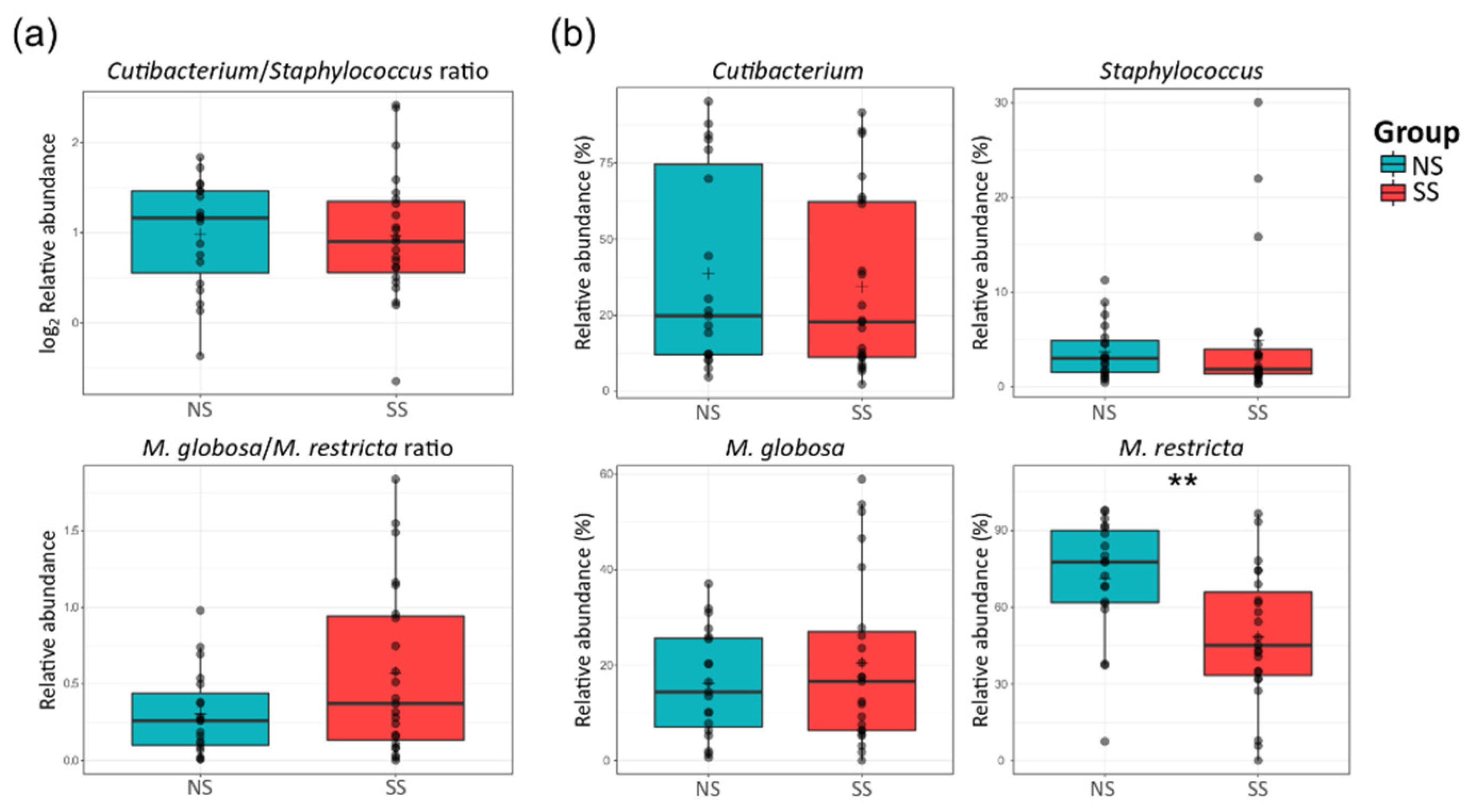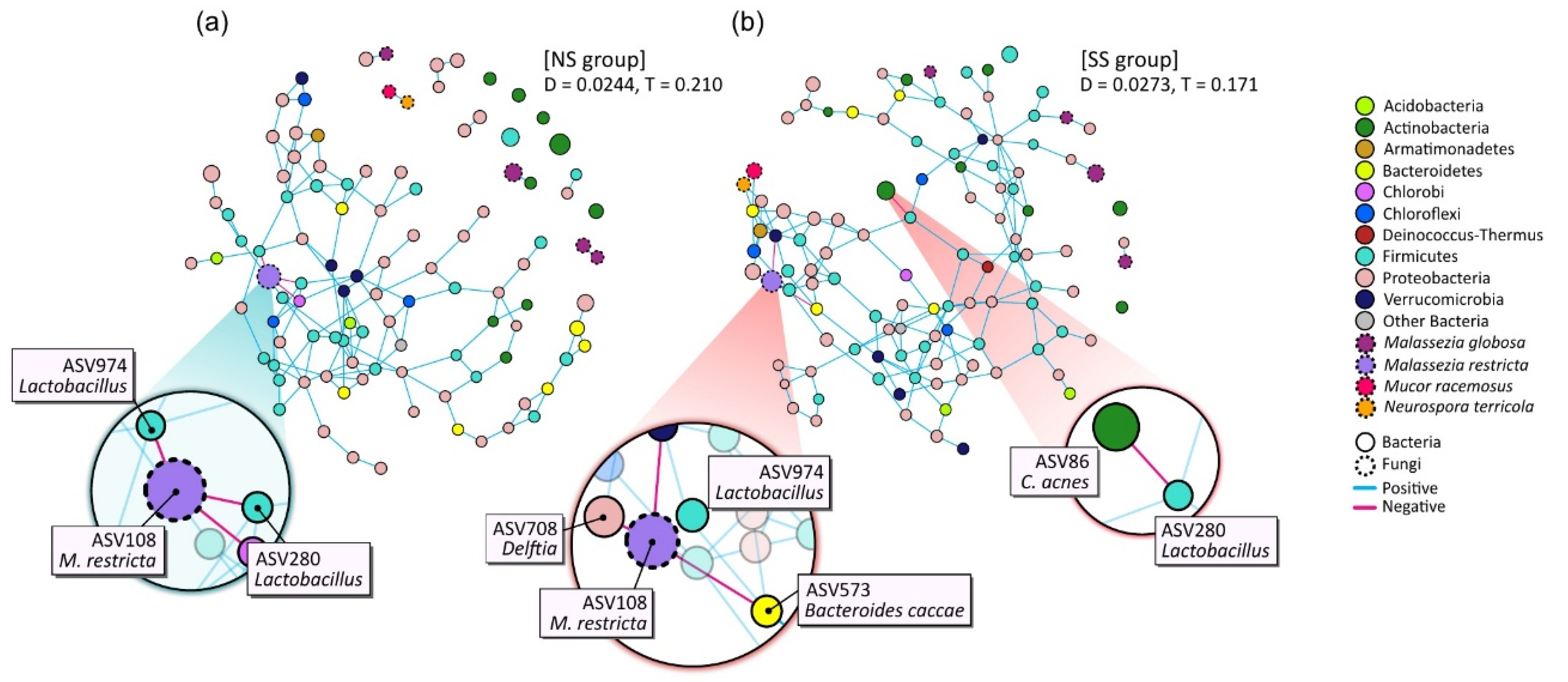Structures of the Skin Microbiome and Mycobiome Depending on Skin Sensitivity
Abstract
:1. Introduction
2. Materials and Methods
2.1. Subject Recruitment and Sample Preparation
2.2. Assessment of Skin Parameters
2.3. Bacterial and Fungal gDNA Extraction
2.4. Next-Generation Sequencing of 16S rRNA Genes and ITS1 Regions
2.5. Analysis of the Skin Microbiome and Mycobiome
2.6. Microbial Network Analysis
2.7. Statistical Analysis
3. Results
3.1. The Skin Characteristics of the Subjects
3.2. Comparison of the Microbiome and Mycobiome of SS and NS
3.3. The Difference in Taxonomic Compostition Between SS and NS
3.4. SS-Specific Microbial Network
3.5. Skin Microbiome and Mycobiome Associated with PS
4. Discussion
Supplementary Materials
Author Contributions
Funding
Conflicts of Interest
References
- Misery, L.; Stander, S.; Szepietowski, J.C.; Reich, A.; Wallengren, J.; Evers, A.W.; Takamori, K.; Brenaut, E.; Le Gall-Ianotto, C.; Fluhr, J.; et al. Definition of Sensitive Skin: An Expert Position Paper from the Special Interest Group on Sensitive Skin of the International Forum for the Study of Itch. Acta Derm. Venereol. 2017, 97, 4–6. [Google Scholar] [CrossRef] [Green Version]
- Berardesca, E.; Farage, M.; Maibach, H. Sensitive skin: An overview. Int. J. Cosmet. Sci. 2013, 35, 2–8. [Google Scholar] [CrossRef]
- Misery, L.; Loser, K.; Stander, S. Sensitive skin. J. Eur. Acad. Dermatol. Venereol. 2016, 30 (Suppl. 1), 2–8. [Google Scholar] [CrossRef] [PubMed]
- Buhé, V.; Vié, K.; Guéré, C.; Natalizio, A.; Lhéritier, C.; Le Gall-Ianotto, C.; Huet, F.; Talagas, M.; Lebonvallet, N.; Marcorelles, P. Pathophysiological study of sensitive skin. Acta Derm. Venereol. 2016, 96, 314–319. [Google Scholar] [CrossRef] [PubMed] [Green Version]
- Pons-Guiraud, A. Sensitive skin: A complex and multifactorial syndrome. J. Cosmet. Dermatol. 2004, 3, 145–148. [Google Scholar] [CrossRef] [PubMed] [Green Version]
- Misery, L.; Boussetta, S.; Nocera, T.; Perez-Cullell, N.; Taieb, C. Sensitive skin in Europe. J. Eur. Acad Dermatol. Venereol. 2009, 23, 376–381. [Google Scholar] [CrossRef] [PubMed]
- Kamide, R.; Misery, L.; Perez-Cullell, N.; Sibaud, V.; Taieb, C. Sensitive skin evaluation in the Japanese population. J. Dermatol. 2013, 40, 177–181. [Google Scholar] [CrossRef]
- Xu, F.; Yan, S.; Wu, M.; Li, F.; Sun, Q.; Lai, W.; Shen, X.; Rahhali, N.; Taieb, C.; Xu, J. Self-declared sensitive skin in China: A community-based study in three top metropolises. J. Eur. Acad. Dermatol. Venereol. 2013, 27, 370–375. [Google Scholar] [CrossRef]
- Farage, M.A. The Prevalence of Sensitive Skin. Front. Med. 2019, 6, 98. [Google Scholar] [CrossRef]
- Chew, A.; Maibach, H. Sensitive skin. In Dry Skin and Moisturizers: Chemistry and Function; Loden, M., Maibach, H., Eds.; CRC Press: Boca Raton, FL, USA, 2000; pp. 429–440. [Google Scholar]
- Roussaki-Schulze, A.; Zafiriou, E.; Nikoulis, D.; Klimi, E.; Rallis, E.; Zintzaras, E. Objective biophysical findings in patients with sensitive skin. Drugs Exp. Clin. Res. 2005, 31, 17–24. [Google Scholar]
- Richters, R.; Falcone, D.; Uzunbajakava, N.; Verkruysse, W.; van Erp, P.; van De Kerkhof, P. What is sensitive skin? A systematic literature review of objective measurements. Skin Pharmacol. Physiol. 2015, 28, 75–83. [Google Scholar] [CrossRef] [PubMed]
- Zeeuwen, P.L.; Kleerebezem, M.; Timmerman, H.M.; Schalkwijk, J. Microbiome and skin diseases. Curr. Opin. Allergy Clin. Immunol. 2013, 13, 514–520. [Google Scholar] [CrossRef] [PubMed]
- Findley, K.; Grice, E.A. The skin microbiome: A focus on pathogens and their association with skin disease. PLoS Path. 2014, 10, e1004436. [Google Scholar] [CrossRef] [PubMed]
- Schommer, N.N.; Gallo, R.L. Structure and function of the human skin microbiome. Trends Microbiol. 2013, 21, 660–668. [Google Scholar] [CrossRef] [PubMed] [Green Version]
- Seite, S.; Misery, L. Skin sensitivity and skin microbiota: Is there a link? Exp. Dermatol. 2018, 27, 1061–1064. [Google Scholar] [CrossRef] [Green Version]
- Zheng, Y.; Liang, H.; Li, Z.; Tang, M.; Song, L. Skin microbiome in sensitive skin: The decrease of Staphylococcus epidermidis seems to be related to female lactic acid sting test sensitive skin. J. Dermatol. Sci. 2020, 97, 225–228. [Google Scholar] [CrossRef]
- An, S.; Moon, S.; Lee, E.; Lee, H. Method for Diagnosing and Analyzing Sensitive Skin and a System for Providing Beauty Information Using the Diagnostic and Analytic Method. Korea Patent 10-0418598; filled 24 December 2000, and issued 2 February 2004,
- Caporaso, J.G.; Kuczynski, J.; Stombaugh, J.; Bittinger, K.; Bushman, F.D.; Costello, E.K.; Fierer, N.; Pena, A.G.; Goodrich, J.K.; Gordon, J.I. QIIME allows analysis of high-throughput community sequencing data. Nat. Methods 2010, 7, 335. [Google Scholar] [CrossRef] [Green Version]
- Martin, M. Cutadapt removes adapter sequences from high-throughput sequencing reads. EMBnet J. 2011, 17, 10–12. [Google Scholar] [CrossRef]
- Rognes, T.; Flouri, T.; Nichols, B.; Quince, C.; Mahé, F. VSEARCH: A versatile open source tool for metagenomics. PeerJ 2016, 4, e2584. [Google Scholar] [CrossRef]
- Bokulich, N.A.; Subramanian, S.; Faith, J.J.; Gevers, D.; Gordon, J.I.; Knight, R.; Mills, D.A.; Caporaso, J.G. Quality-filtering vastly improves diversity estimates from Illumina amplicon sequencing. Nat. Methods 2013, 10, 57. [Google Scholar] [CrossRef]
- Amir, A.; McDonald, D.; Navas-Molina, J.A.; Kopylova, E.; Morton, J.T.; Xu, Z.Z.; Kightley, E.P.; Thompson, L.R.; Hyde, E.R.; Gonzalez, A. Deblur rapidly resolves single-nucleotide community sequence patterns. mSystems 2017, 2, e00191-16. [Google Scholar] [CrossRef] [PubMed] [Green Version]
- Bokulich, N.A.; Kaehler, B.D.; Rideout, J.R.; Dillon, M.; Bolyen, E.; Knight, R.; Huttley, G.A.; Caporaso, J.G. Optimizing taxonomic classification of marker-gene amplicon sequences with QIIME 2’s q2-feature-classifier plugin. Microbiome 2018, 6, 90. [Google Scholar] [CrossRef] [PubMed]
- Rivers, A.R.; Weber, K.C.; Gardner, T.G.; Liu, S.; Armstrong, S.D. ITSxpress: Software to rapidly trim internally transcribed spacer sequences with quality scores for marker gene analysis. F1000Research 2018, 7, 1418. [Google Scholar] [CrossRef] [PubMed]
- Farage, M.A.; Maibach, H. Sensitive skin: Closing in on a physiological cause. Contact Derm. 2010, 62, 137–149. [Google Scholar] [CrossRef]
- Oh, J.; Byrd, A.L.; Park, M.; Kong, H.H.; Segre, J.A. Temporal stability of the human skin microbiome. Cell 2016, 165, 854–866. [Google Scholar] [CrossRef] [Green Version]
- Prescott, S.L.; Larcombe, D.-L.; Logan, A.C.; West, C.; Burks, W.; Caraballo, L.; Levin, M.; Van Etten, E.; Horwitz, P.; Kozyrskyj, A. The skin microbiome: Impact of modern environments on skin ecology, barrier integrity, and systemic immune programming. World Allergy Organ. J. 2017, 10, 29. [Google Scholar] [CrossRef]
- Jo, J.-H.; Kennedy, E.A.; Kong, H.H. Topographical and physiological differences of the skin mycobiome in health and disease. Virulence 2017, 8, 324–333. [Google Scholar] [CrossRef] [Green Version]
- Leung, M.H.; Chan, K.C.; Lee, P.K. Skin fungal community and its correlation with bacterial community of urban Chinese individuals. Microbiome 2016, 4, 46. [Google Scholar] [CrossRef] [Green Version]
- Takemoto, A.; Cho, O.; Morohoshi, Y.; Sugita, T.; Muto, M. Molecular characterization of the skin fungal microbiome in patients with psoriasis. J. Dermatol. 2015, 42, 166–170. [Google Scholar] [CrossRef]
- Tanaka, A.; Cho, O.; Saito, M.; Tsuboi, R.; Kurakado, S.; Sugita, T. Molecular characterization of the skin fungal microbiota in patients with seborrheic dermatitis. J. Clin. Exp. Dermatol Res. 2014, 5, 239. [Google Scholar]
- Zaneveld, J.R.; McMinds, R.; Thurber, R.V. Stress and stability: Applying the Anna Karenina principle to animal microbiome. Nat. Microbiol. 2017, 2, 1–8. [Google Scholar] [CrossRef] [PubMed]
- Ma, Z.S. Testing the Anna Karenina principle in human microbiome-associated diseases. iScience 2020, 23, 101007. [Google Scholar] [CrossRef]
- Hillion, M.; Mijouin, L.; Jaouen, T.; Barreau, M.; Meunier, P.; Lefeuvre, L.; Lati, E.; Chevalier, S.; Feuilloley, M. Comparative study of normal and sensitive skin aerobic bacterial populations. Microbiologyopen 2013, 2, 953–961. [Google Scholar] [CrossRef]
- Lin, R.; Aziz, M.; Yoo-Bowne, H. Maxillary sinus mycetoma associated with hypersensitivity to Mucor racemosus. Internet J. Asthma Allergy Immunol. 2006, 5. Available online: http://ispub.com/IJAAI/5/1/12518 (accessed on 10 July 2020).
- Apold, J.; Havnen, J.; Hvatum, M.; Oseid, S.; Aas, K. The radioallergosorbent test (RAST) in the diagnosis of reaginic allergy: A comparison between provocation tests, skin tests and RAST employing allergo-sorbents which were arbitrarily prepared with commercial allergen extracts. Clin. Exp. Allergy 1974, 4, 401–409. [Google Scholar] [CrossRef]
- Taskinen, T.; Laitinen, S.; Hyvärinen, A.; Meklin, T.; Husman, T.; Nevalainen, A.; Korppi, M. Mold-specific IgE antibodies in relation to exposure and skin test data in schoolchildren. Allergol. Int. 2001, 50, 239–245. [Google Scholar] [CrossRef] [Green Version]
- Frosch, P.J.; Kligman, A.M. A method for appraising the stinging capacity of topically applied substances. J. Soc. Cosmet. Chem. 1977, 28, 197–209. [Google Scholar]
- Lee, C.H.; Maibach, H.I. The sodium lauryl sulfate model: An overview. Contact Derm. 1995, 33, 1–7. [Google Scholar] [CrossRef]
- Smith, W. Comparative effectiveness of α-hydroxy acids on skin properties. Int. J. Cosmet. Sci. 1996, 18, 75–83. [Google Scholar] [CrossRef]





| Variable | Overall (n = 42) | NS (n = 19) | SS (n = 23) |
|---|---|---|---|
| a. Basic Information | |||
| Mean age (SD) | 35.0 (8.6) | 37.8 (8.3) | 32.6 (8.2) |
| b. Subjective Information | |||
| Perceived Skin Type (%) | |||
| Dry | 15 (35.7%) | 6 (31.6%) | 9 (39.1%) |
| Combination | 17 (40.5%) | 7 (36.8%) | 10 (43.5%) |
| Normal | 7 (16.7%) | 4 (21.1%) | 3 (13.0%) |
| Oily | 3 (7.1%) | 2 (10.5%) | 1 (4.3%) |
| Perceived Skin Sensitivity (%) | |||
| Level 1 | 2 (4.8%) | 2 (10.5%) | 0 |
| Level 2 | 4 (9.5%) | 4 (21.1%) | 0 |
| Level 3 | 6 (14.3%) | 5 (26.3%) | 1 (4.3%) |
| Level 4 | 9 (21.4%) | 7 (36.8%) | 2 (8.7%) |
| Level 5 | 12 (28.6%) | 1 (5.3%) | 11 (47.8%) |
| Level 6 | 7 (16.7%) | 0 | 7 (30.4%) |
| Level 7 | 2 (4.8%) | 0 | 2 (8.7%) |
| Mean (SD) *** | 4.29 (1.52) | 3.05 (1.13) | 5.30 (0.93) |
| c. Skin Parameters (SD) | |||
| Hydration | 47.43 (16.80) | 46.55 (16.51) | 48.16 (17.37) |
| Sebum | 17.37 (18.60) | 19.68 (22.74) | 15.46 (14.60) |
| Melanin | 0.54 (0.060) | 0.56 (0.049) | 0.53 (0.067) |
| Maximum Temperature | 36.49 (0.45) | 36.52 (0.52) | 36.46 (0.39) |
| Minimum Temperature | 28.43 (2.57) | 28.07 (2.87) | 28.75 (2.30) |
| Average Temperature | 34.20 (0.94) | 34.28 (0.94) | 34.13 (0.95) |
| Elasticity (skin touch) | 69.93 (12.26) | 67.53 (12.17) | 71.91 (12.24) |
© 2020 by the authors. Licensee MDPI, Basel, Switzerland. This article is an open access article distributed under the terms and conditions of the Creative Commons Attribution (CC BY) license (http://creativecommons.org/licenses/by/4.0/).
Share and Cite
Keum, H.L.; Kim, H.; Kim, H.-J.; Park, T.; Kim, S.; An, S.; Sul, W.J. Structures of the Skin Microbiome and Mycobiome Depending on Skin Sensitivity. Microorganisms 2020, 8, 1032. https://doi.org/10.3390/microorganisms8071032
Keum HL, Kim H, Kim H-J, Park T, Kim S, An S, Sul WJ. Structures of the Skin Microbiome and Mycobiome Depending on Skin Sensitivity. Microorganisms. 2020; 8(7):1032. https://doi.org/10.3390/microorganisms8071032
Chicago/Turabian StyleKeum, Hye Lim, Hanbyul Kim, Hye-Jin Kim, Taehun Park, Seoyung Kim, Susun An, and Woo Jun Sul. 2020. "Structures of the Skin Microbiome and Mycobiome Depending on Skin Sensitivity" Microorganisms 8, no. 7: 1032. https://doi.org/10.3390/microorganisms8071032
APA StyleKeum, H. L., Kim, H., Kim, H.-J., Park, T., Kim, S., An, S., & Sul, W. J. (2020). Structures of the Skin Microbiome and Mycobiome Depending on Skin Sensitivity. Microorganisms, 8(7), 1032. https://doi.org/10.3390/microorganisms8071032





